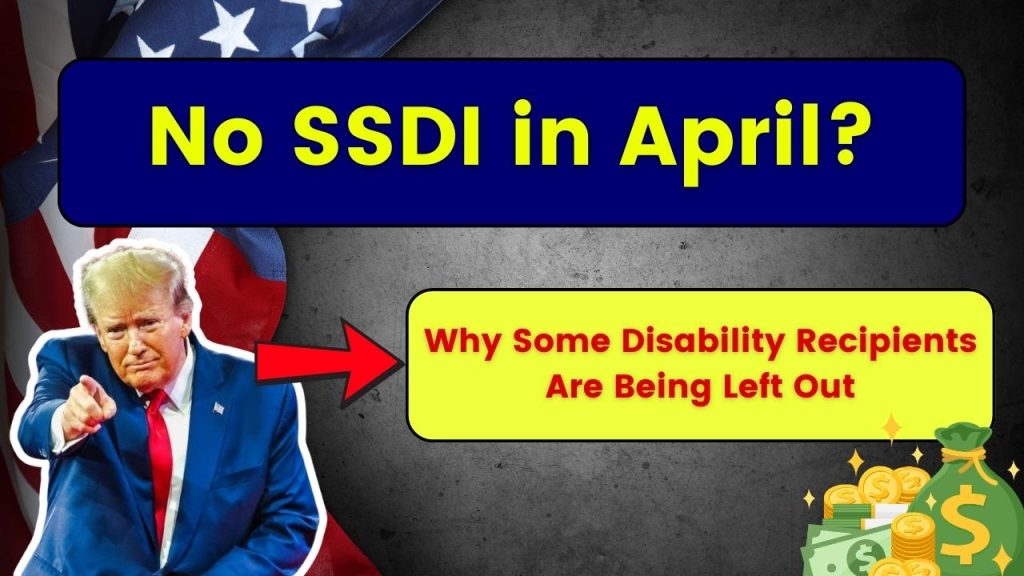No SSDI in April: Millions of Americans rely on Social Security Disability Insurance (SSDI) to meet their basic needs. It helps pay for rent, groceries, prescriptions, and daily essentials. That’s why when SSDI recipients noticed what looked like a delay in their April 2025 payments, confusion and concern spread fast. People turned to forums, social media, and search engines, asking: “No SSDI in April? What’s going on?”

If you’re one of the millions affected—or simply curious about what’s behind the rumors—this article is here to help. We’ll explain what’s really happening, offer expert insights, and walk you through everything you need to know to stay informed, calm, and in control.
The reality? Most SSDI recipients are not being left out of April payments. But a combination of SSA’s staggered payment system, policy updates, and poor communication has led to widespread misunderstanding. Let’s clear that up.
No SSDI in April
| Topic | Details |
|---|---|
| April SSDI Payment Dates | April 3, 9, 16, and 23 depending on the recipient’s birthdate and claim history. |
| Who Gets Paid First? | Those who started receiving SSDI before May 1997 are paid on April 3. |
| Why the Delay for Some? | Birthdate-based payment schedule, not a stoppage or cut. |
| SSA Policy Changes? | Delayed implementation of new ID requirements due to public concern. |
| Where to Check Payment Status | ssa.gov – sign in to “my Social Security” account. |
The buzz about “no SSDI in April 2025” has caused unnecessary panic. But rest assured, SSDI payments are being issued as scheduled. The confusion stems from the SSA’s birthdate-based schedule and unrelated news about identity verification requirements.
If you haven’t seen your deposit yet, don’t worry. Follow the steps in this guide to verify your status, speak to your bank, and contact SSA if needed. And most importantly, remember—you’re not alone. Many others are navigating the same situation, and support is available.
Understanding the SSDI Payment Schedule
Many assume that everyone on SSDI gets paid at the same time each month. But the Social Security Administration (SSA) doesn’t work that way. Instead, it follows a staggered payment schedule based on two key factors:
- Your birth date, and
- When you first began receiving SSDI benefits.
Here’s the breakdown for April 2025:
- April 3: People who started receiving benefits before May 1997.
- April 9: For recipients born between the 1st and 10th of any month.
- April 16: For recipients born between the 11th and 20th.
- April 23: For recipients born between the 21st and 31st.
So if your birthday falls later in the month—or you started receiving benefits recently—your payment will arrive later. This isn’t a delay or a policy change. It’s simply the regular schedule in action.
“The SSA payment system works like clockwork, but it’s often misunderstood. Timing isn’t about favoritism—it’s logistics,” says Mary Collins, a retired SSA employee and disability rights advocate with over 30 years of experience.
Tip: Set Calendar Alerts
Use your phone’s calendar or a budgeting app to set reminders for your payment date based on your birthdate. It’s an easy way to reduce stress and stay organized. You can find the full payment schedule on the SSA’s official calendar.
What Sparked the Confusion This Month?
The rumor mill got a big boost in late March 2025, when the SSA announced new identity verification requirements for some applicants and current beneficiaries. The idea was to strengthen fraud prevention by requiring in-person ID checks.
However, after a wave of criticism from disability rights advocates, the SSA delayed the policy rollout. According to a March 26, 2025 report from Reuters, several planned service reductions were also paused following feedback from national advocacy groups like the National Disability Rights Network. (Source)
Although these changes didn’t directly impact payment dates, the announcement triggered fear and confusion—especially for recipients who hadn’t yet received their April SSDI deposits.
What to Do If You Haven’t Received Your SSDI Payment
If your payment hasn’t arrived yet, don’t panic. Follow these simple steps to track it down:
Step 1: Confirm Your Payment Date
Go to the SSA’s “my Social Security” portal. Sign in to check your scheduled deposit date. Compare it to your birth date and the SSA calendar.
Step 2: Check with Your Bank or Credit Union
Sometimes, the issue is on the financial institution’s end—not SSA’s. Check for technical issues, holds, or internal delays. If you use a prepaid debit card, log in to that card’s portal or call customer support.
Step 3: Wait 3 Mailing Days
The SSA advises waiting three business days before reporting a missed payment. Direct deposits are typically prompt, but mailed checks can be slowed by weather, holidays, or postal issues.
Step 4: Contact the SSA
If the waiting period has passed, reach out to SSA directly at 1-800-772-1213, or visit your nearest field office. Be sure to bring valid ID and any relevant documentation like past statements or your award letter.
How SSDI Payment Delays Can Impact Lives
Even a short delay can cause serious stress. SSDI recipients include individuals with physical disabilities, chronic illnesses, and mental health conditions. Many are on fixed incomes and have limited options.
Here’s how missed payments can create a ripple effect:
- Food insecurity: Groceries get skipped, especially at the end of the month.
- Late rent or utility bills: This can lead to late fees or housing instability.
- Medical consequences: Delays in buying prescriptions or attending appointments.
- Mental health impacts: Uncertainty about income adds to emotional strain.
“We’re seeing increased calls to food pantries right after the 1st of the month from SSDI recipients who thought their payment was late,” says Elena Ramirez, director at Helping Hands Community Center in Chicago.
Financial Tips: How to Prepare and Plan Ahead
- Create a Small Emergency Fund: Set aside $20-$30 a month if possible. In 4–5 months, that’s a helpful buffer.
- Use Budgeting Tools: Try free apps like Mint, Goodbudget, or the envelope method. Know where every dollar goes.
- Set Up Smart Alerts: Ask your bank to notify you of incoming deposits or low balances.
- Adjust Your Bill Due Dates: Contact service providers to align due dates with your SSDI deposit.
- Explore Additional Benefits: Visit Benefits.gov to find out if you’re eligible for food assistance, utility help, or local aid programs.
Will SSI & SSDI Disability Benefits Get a Big Boost in 2026? Check the COLA Increase Projection!
$1,580 SSDI Benefits in April 2025: Check Payment Dates and Eligibility Criteria!
$1,580 SSDI Payment Confirmed for April 2025 – Who’s Getting It? Check Eligibility
FAQs About No SSDI in April
Is SSDI ending or being cut?
Absolutely not. SSDI is federally funded and remains fully operational. There are no current or proposed benefit cuts.
Why didn’t I get paid on April 1?
SSDI doesn’t pay on the 1st unless you also receive Supplemental Security Income (SSI). If you’re SSDI-only, your payment will be issued according to the birthdate-based schedule.
Will I always get paid on the same day every month?
Yes, usually. If your payment date falls on a weekend or holiday, it will be processed the business day before.
Can SSDI be withheld or garnished?
Yes, but only in limited cases such as:
- Unpaid federal taxes
- Child support obligations
- Defaulted federal student loans
For questions about garnishment, speak to a Social Security representative or consult a legal advisor.
Where do I report a missing SSDI payment?
- Call the SSA at 1-800-772-1213
- Visit your local SSA office
- Or log into your “my Social Security” account for updates











